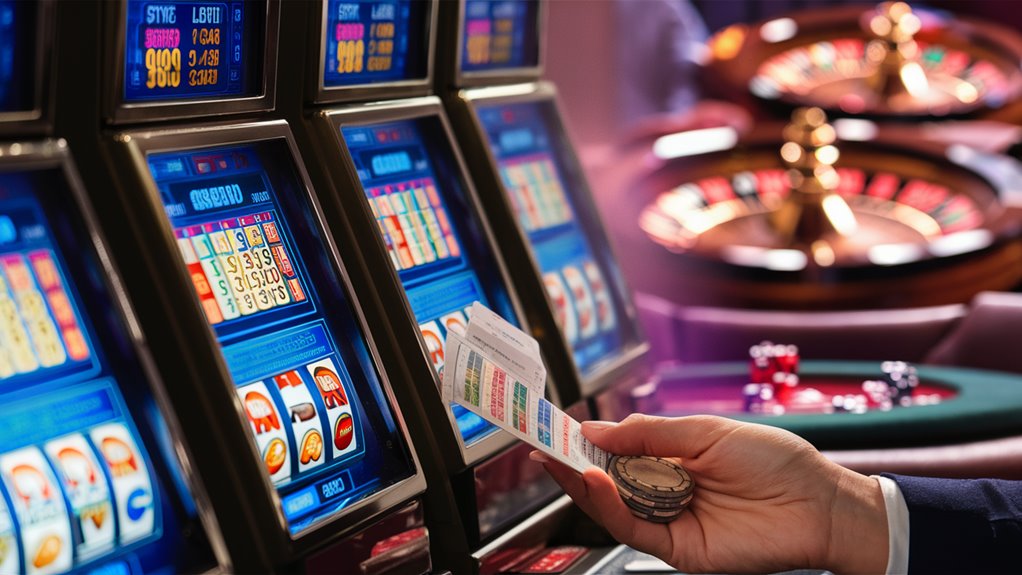An In-depth Look at the Percentage of Money Won in Gaming Software that Goes Back to Gamblers
Return to Player (RTP)
This figure represents what players can expect to receive back from the casino over time in the form of a theoretical percentage. All this is calculated across thousands of individual play sessions and therefore, provides long-term projections that are finally being realized.
Payout Rates for Different Games
Slot Machines
Traditional Slots: 85-98% Return to Player (RTP)
Penny Slots: 88-92% Return to Player (RTP)
High-Denomination Slots: 95-97% Return to Player (RTP)
Table Games
Blackjack: Up to 99.5% with proper strategy
Baccarat: 98.9% Return to Player (RTP) average
Roulette: 94.74% (European), 92.1% Return to Player (RTP) (American)
Regulatory Requirements and Compliance
Gaming commissions in the U.S. require that their minimum payout percentage range from 75-83%. Regular audits are performed to make sure that these standards are complied with by the casinos, thus protecting the players’ rights and ensuring integrity in this industry.
How the Size of the Bets Affects Returns
Therefore, the more you are prepared to bet, the better your long-run return is likely to be:
$1 Slots: 94-95% average return
$5 Slots: 95-96% average return
$25+ Slots: 96-97% average return
Strategy and Tactics
Understanding payout percentages is vital to the creation of effective gaming strategies. Here’s some advice for the beginner to remember.
Choose which games to play based on their payout rates
Choose denominations that offer a return on investment
Strategic implementation of gaming-specific strategies
How much you should have set aside for gaming finances given the expected returns at different denominations
The more a player knows, obviously, the better decisions he or she can make about his or her play, and the more enhancing his or her experience will be. All this as a human being looks for an edge to maximize returns on what little (s) he has invested.
We have more chance of approaching the outlined theoretical value the longer our sample period. Due to regular audits by management and outside parties, a casino’s independence and the fairness of its games are protected simultaneously. Time and time again, new tricks are churned out by statisticians.
Nonetheless, there do remain some rather significant differences in average expected return rate among table games and slot machines with video-technology. Very large single bets on a particular outcome (e.g., in craps) may get around this by paying such high odds that they produce an abnormally high AR T. The major reason that draw poker has much higher grounding in statistically verified truth today than in yesterday’s, and so many people are investing their time playing it, is because criminal charges concerning a couple of important points have been overturned. Expected Return: This is the sum of all possible winnings before the player starts betting and the house accepts that bet. Hence the reason that certain machines (drawing or standing on soft 17, for example) tend to run at a higher return rate than others is simply that each player’s risk level and style is just a little different from his neighbor’s.
We will conduct a detailed comparison of the short-term expectation and RTP in different games later on, however for now just consider that most games offer lower percentage returns over a longer period of time. An exception to this would be slot machines where you can achieve very high payouts from just coming across one or two winning combinations in one or two months. In other words, we will look at both tables and machines that have been final approved for use.
Blackjack RTP Factors
The Effect of Dealer Stand/Hit Rules on Soft 17
The number of decks in play
Actions allowed to players
House Edge Variations
Roulette Analysis
The Difference Between Single Zero and Double Zero Wheels
Probability Calculations
Metrics on Expected Returns
Regulatory Compliance and Verification
Gaming regulators require rigorous RTP verification procedures: Melding Smoky Freedoms With Radiant Pot Momentum
Minimum legal standards (75-83% depending on jurisdiction)
Independent auditing requirements
Certification documentation
Statistical testing protocols
Compliance verification before
Only by fully understanding these mathematical principles can we make sound RTP calculations and ensure the gaming fairness of a casino.
House Edge of Casino Games
Understanding House Edge: A Full Guide
Essential House Edge Fundamentals
The house edge is the mathematical advantage that casinos have across their whole range of games.
While RTP (Return to Player) calculations provides a general payment metric for all casinos, in order to make informed gambling decisions, one must know the house edge rates for specific games.
Low House Edge Casino Games
For a very low edge of 0.5% to 1% using proper basic strategy, Blackjack is a standout success.
Baccarat provides the best odds with a 1.06% house edge on banker bets and 1.24% on player bets.
Craps offers good odds through its 1.41% pass line bet and 1.36% don’t pass bet.
Medium to High House Edge Games
In double-zero games such as American Roulette, the house edge is much higher at 5.26% than in single-zero Plains & no-go areas like the Board (2.7%).
Slot Machine has variable house edges ranging from 2% to 15% depending on jurisdictions and casino settings.
Highest House Edge Games
Among the most common casino games, Keno probably has the highest house edge, varying from 20% to 40%.
Skill-based games have better odds than those that are purely luck of chance, where the house consistently favors it more.
Strategic Game Selection
For best gaming results, bet on games where player abilities can affect the result.
Return to Player (RTP) Machine Payout Statistics table games like blackjack and baccarat consistently offer superior odds compared to automated games of pure luck.
Return to Player (RTP) Regulations and Standards: Understanding Slot Machine Payout Statistics and Return Rates
Today’s slot machines sport a regulated payback period of between 85% and 98%.
Each jurisdiction has differing minimum RTP requirements, with Nevada mandating a 75% rate and New Jersey preferring 83%. Weaving Coarse Reels Into Silken, Bonus-Focused Patterns
Casino operators usually exceed these minimums dramatically in order to keep their competitive edge.
Hit Frequency and Win Patterns
Hit frequency is the essential metric of how often you win a spin.
Most slot machines eventually payback something, as 20%-45% of spins will win some cash. But many wins are less than the machine’s minimum bet–or zero at all.
Progressive slot machines usually have a lower hits frequency rate, but they offer much greater top payouts.

Volatility Ratings and Payout Structures
Low vs High Volatility Machines
Low volatility slots: Small frequent payouts
High volatility slots: Fewer, larger wins
Denomination-Based Return Rates
Penny slots: 88-92% RTP
Mid-denomination machines (1-): 95-97% RTP
A machine’s variance directly affects how long you can expect to be playing and what bankroll management is required.
These figures are all taken from the statistical return over millions of spins. The results of individual sessions can differ greatly from such averages.
Regulatory data shows that higher denomination slots consistently offer a better return percentage than low denomination slots.
Table Games Vs Machine Payouts
Table Games vs Machine Payouts: A Complete Casino Guide
Understanding Casino Game Return Rates: Casino gambling presents two alternate activities for the novice, rather like fishing or hunting: table games and machines.
Return to Player (RTP) Because of table games and baccarat’s MC computer strategy, the return to player percentage stands at 98-99.5%, while on slot machines it is much lower with 75-95%.
Table gaming, unlike other forms of gambling, allows you to control your own luck through strategic decision-making. Energizing Subtle Bloom Freedoms for High-Voltage Table Outcomes
Through employing a perfect basic strategy, blackjack players can reduce the edge the house has on them to just 0.5 percent.
Similarly, craps contains numerous points where bets are possible and house advantages in the low single digits; yet, roulette imposes a standard 5.26% advantage at every wager of the table.
Mechanics and Regulations Pertinent to Machine Gaming
Electronic gaming machines fall under rigorous regulatory control, and they are all powered by computer circuits and random number sequences.
While a few video poker machines such as Deuces Wild can be played with a positive expectation, most slots pay back less than 90% of what is put into them on average–and very few offer anything that even comes close to 99%. Casino slot machines typically return between 88.0 and 92.0 percent as determined by coin-in vs pay-out (coin out).
States vary significantly in the legal minimum level of payback on slots – Nevada requires 75%, while New Jersey demands that casinos offer an 83% minimum return to players.
RTP at a Glance
Blackjack: 98-99.5%
Baccarat: 97.3%
Video Poker: Up to 99.54%
Slot Machines: 85-95 pct. average
Craps: Various under 98%
Roulette: 94.74% (standard American)
Locating Official Casino Payout Reports
Analysis of State Casino Payout Reports: Comprehensive Guide
Accessing Official Casino Reporting Data
Casino payouts present important news bulletins on the state of play of casinos across regions.
These official documents, published by the state gaming commissions and regulatory authorities, provide extensive information on game returns as well as operational data.
With this information, new players can make an informed decision when they decide which one and where to play.
Key Metrics in Payout Reports
The most important concept in the document is according to Russell K. Robbins its ‘hold’ percentage: that shows how much of total intermeds which casinos retain themselves from every dollar bet.
This is converted into house advantage by doing a simple calculation: 100% – hold rate = return rate for player.
Sectional data shows how perfects of and casino wins are distributed, 먹튀검증커뮤니티
Penny Slots
Nickel Machines
Quarter games
Denomination of Dollar
Analyzing Trends in Performance
Monthly and quarterly reports offer the most valuable manifestations of today’s patterns in the operation. Essential input for analysis includes:
Hold (expected and actual) percentage
Percentage of Game Type Participation
Historical performance guide
Year-by-year comparison
Statistical Relevance
Given that payout reports simply present historical performance data, so they tell more about how things have been than what will happen. Such legal documents help one to discern: What denominations yield the highest paybacks Which game is the best to play Patterns of performance specific to the property Variations in regulatory payouts
Understanding these reports will help a player figure out which locations offer historically better returns and which games have awarded consistently higher payouts over time. Past performance is no guarantee of future results.
Maximize Your Winning Potential
Maximize Your Winning Potential in Casino Gaming
Understanding RTP and Game Selection
Return to Player (RTP) percentages determine, to a high degree, whether a casino triumphs or fails.
Your best play in video poker is up to 99.54% RTP, while some slot machines on high-denomination pay back between 96-98 %.
These calculations should always be checked in official gaming commission reports from your jurisdiction.
Strategic Management of Your Bankroll
Effective bankroll management combines making high-RTP game selections and disciplined betting on them. Always use a 2% rule for your bankroll allotment per session and set loss limits.
Working out machines for their volatility ratings and RTP figures- lower volatility machines usually provide steady, smaller winnings.
Optimal Strategy For Table Games
Table games offer better mathematical odds over the long run if they are all played according to strategy:
Baccarat: 1.06% house edge on banker bets
Blackjack: 0.5% house edge w/basic strategy
Craps 1.36% house edge on the pass line
Track Each Gaming Session
Make a life’s work of monitoring and details so that you bring back knowledge from the real world to judge against published rates of return.
Using this performance data: make fine-tuned decisions about where you play; go for better-performing games.
Document results in a consistent and systematic way to track patterns of performance and so gain insights into intelligent future gaming choices.


